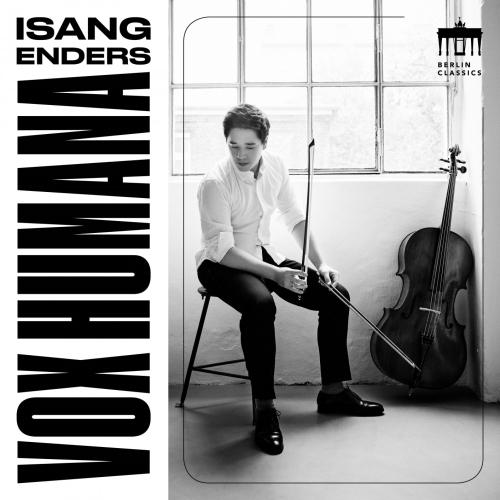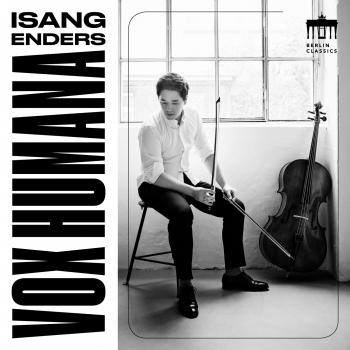
Vox Humana Isang Enders
Album Info
Album Veröffentlichung:
2020
HRA-Veröffentlichung:
24.04.2020
Das Album enthält Albumcover
- Marin Marais (1656 - 1728): Pièces de Viole, livre III:
- 1 Pièces de Viole, livre III: No. 13 Grand ballet (Arr. for two cellos) 04:15
- Claude Debussy (1862 - 1918): Sonate pour Violoncelle et Piano, L. 135:
- 2 Sonate pour Violoncelle et Piano, L. 135: I. Prologue: Lent, sostenuto e molto risoluto 04:39
- 3 Sonate pour Violoncelle et Piano, L. 135: II. Sérénade: Modérément animé 03:27
- 4 Sonate pour Violoncelle et Piano, L. 135: III. Final: Animé, léger et nerveux 03:53
- Nadia Boulanger (1887 - 1979): Trois Pièces pour Violoncelle et Piano:
- 5 Trois Pièces pour Violoncelle et Piano: No. 1 Moderato 03:11
- 6 Trois Pièces pour Violoncelle et Piano: No. 2 Sans vitesse et à l'aise 02:08
- 7 Trois Pièces pour Violoncelle et Piano: No. 3 Vite et nerveusement rythmé 02:36
- Lili Boulanger (1893 - 1918): Deux Pièces pour Violon et Piano:
- 8 Deux Pièces pour Violon et Piano: No. 1 Nocturne (Arr. for Cello and Piano) 04:11
- Igor Stravinsky (1882 - 1971):
- 9 Elegy (1944) (Arr. for Cello solo) 05:24
- Marin Marais: Pièces de Viole, Livre II, No. 63:
- 10 Pièces de Viole, Livre II, No. 63: No. 63 Les Voix humaines (Arr. for two Cellos) 04:45
- Claude Debussy:
- 11 Intermezzo, L. 26, No. 1 05:14
- 12 Suite Bergamasque, L. 75: No. 3 Clair de lune (Arr. for Cello and Guitar) 05:01
- 13 Pantomime, L. 31 (Arr. for Cello and Piano) 02:46
- 14 Les Angélus, L. 76 (Arr. for Cello and Guitar) 03:25
- Olivier Messiaen (1908 - 1992): "Fête des Belles eaux" (1937):
- 15 "Fête des Belles eaux" (1937): No. 2 L'eau (Arr. for Cello and Harmonium) 10:49
- Claude Debussy:
- 16 Beau Soir, L. 6 (Arr. for Cello and Piano) 02:44
Info zu Vox Humana
Mit Vox Humana legt der Cellist Isang Enders ein gleichsam durchdachtes Konzeptalbum, eine Studie des Klangs und das Abbild eines musikalischen Beziehungsnetzes vor. Sorgfältig wählt er für seine dritte Veröffentlichung bei Berlin Classics französische Werke aus vier Jahrhunderten aus, setzt sich mit jedem auf ganz individuelle Weise auseinander und stellt sich selbst und den Hörer vor die Aufgabe, nicht nur zuzuhören, sondern wahrzunehmen.
Den Ausgangspunkt seiner Betrachtung findet der Isang Enders bei Claude Debussy. „Als ich das erste Mal Debussy gespielt habe, bekam ich von meinem damaligen Lehrer die Anweisung: „viel Bogen, wenig Druck, viel Luft“. Bei Debussy steht jedoch über jedem Ton ganz genau, wie er gespielt werden muss. Innerhalb dieses Korsetts dann eine Interpretation entstehen zu lassen, basiert auf Timing und Klangfarbe. Man muss seinen Kleiderschrank aufmachen und wirklich nach jeder Farbe und Struktur suchen, die man finden kann. Das ist mühsam.“ Von Debussy und seinen Klangfarben aus wirft Isang Enders einen Blick in Vergangenheit und Zukunft.
In Marin Marais sieht er einen musikalischen Vorfahren Debussys, dessen Musik „unglaublich gesanglich“ ist, „viel mehr, als man gemeinhin annimmt“. Von diesem barocken Vorgänger aus lässt Enders seinen Blick bis tief ins 20. Jahrhundert streifen – über Stravinsky, die Boulanger-Schwestern Lili und Nadia zu Messiaen, „die logische Konsequenz aus Debussy.“ Im Zentrum steht für Enders dabei immer die Frage: Wie unterscheiden sich die Klangvorstellungen der einzelnen Komponisten und wie lassen sie sich auf dem stimmen-ähnlichem Cello umsetzen? Die Mehrheit der Stücke auf dem Vox Humana ist nicht ursprünglich für Cello geschrieben; Enders musste sie arrangieren, konnte so aber noch mehr auf die einzelnen Werke eingehen. So setzt er Debussy u.a. für Cello und Gitarre um, spielt Marais mit zwei Celli und Messiaen mit Harmonium, Orgel und dem seltenen Theremin, „im Grunde eine elektrische vox humana. Ich folge den Stimmungen, die sich aus den jeweiligen Stücken ergeben: die sakrale, chorische Tonsprache des Clair de lune, der burschikose letzte Satz von Nadia Boulanger, dieses Feuer und diese Fantasie, was man dann im Intermezzo und in der Pantomime wiederfindet. Und dann wieder Marais mit Les Voix humaines, wo man wirklich das Gefühl hat, einem Menschen beim Singen zuzuhören.“
Isang Enders spricht von barocken und impressionistischen Legato-Bögen, von der Ästhetik der Schärfe, von Farb- und Kontraststrukturen und spannt so einen großen Bogen zwischen den Epochen, dass alle Werke gleichzeitig näher zusammenrücken und doch in ihrer Eigenständigkeit an Detailreichtum zunehmen. Seine musikalischen Partner auf Vox Humana sind ebenso seine persönlichen Wegbegleiter: den Pianisten Sunwook Kim, den schottischen Gitarristen Sean Shibe und seinen Cello-Kollegen Mischa Meyer kennt er durch seine rege Konzerttätigkeit auf allen Kontinenten, sein Studium oder die Stelle als 1. Konzertmeister der Violoncelli der Sächsischen Staatskapelle Dresden, die er als 20-jähriger antrat. Die berühmte Thereministin Carolina Eyck, die mit ihrem besonderen Instrument auf der ganzen Welt unterwegs ist, kennt er aus dem Jugendorchester und nicht zuletzt sein Vater ist auf dem Album an Harmonium und Orgel vertreten.
Isang Enders, Cello
Isang Enders
born in Frankfurt/Main in 1988, is the son of a German-Korean family with both parents being musicians. At the age of nine years he got the first time into touch with a cello and only a short time later he began his early studies in the class of Prof. Michael Sanderling at the Frankfurt Music Academy. Six years later he became a student of Prof. Gustav Rivinius at the University of Music Saar. Taking part in numerous master classes being held by professors like David Geringas, Janos Starker, Steven Isserlis as well as by the composer Krzysztof Penderecki enabled Isang Enders to improve his skills in playing the cello. The longlasting close personal contact with the American cellist Lynn Harrell advancing him intensely, too was of great importance for the young artist.
As a Stipendiat der Studienstiftung des Deutschen Volkes and the German Foundation Musikleben the young artist enjoyed an intense promotion. As a prize winner of the Deutscher Musikinstrumentenfonds he was given as a loan in trust a „Joseph Gagliano Neapoli 1720” violoncello owned by a Hamburg family.
Awarded with the Darmstädter Musikpreis 2007 and the Lichtenberger Musikpreis 2008 of the Land Hessen, Isang Enders – with only 20 years of age - was engaged to the Semper Opera House, to the more than one decade vacant position of the lead concertmaster of the violoncelli of the Sächsische Staatskapelle Dresden in June 2008.
As a soloist Isang Enders has already performed with orchestras like the Rundfunk-Sinfonieorchester Berlin, the Philharmonic Orchestras in Kiel, Erfurt and Darmstadt, he gave concerts in Innsbruck, Krakow, Belgrade, Seoul, Giessen, Berlin, at the Rheingau Musik Festival, the Festspiele Mecklenburg-Vorpommern as well as with the Deutsche Streicherphilharmonie going on tour with them under the baton of Michael Sanderling in 2010. In addition he gave concerts with the Junge Kammerphilharmonie Hessen in Cyprus and Israel in October 2010.
Isang Enders also well known as a chamber musician is a welcome guest at prestigious national and international festivals.
In this field, Olivier Messiaen's Quatuor pour la fin du temps with the conductor and pianist Myung-Whun Chung in 2008, the advancement in Seiji Ozawa's IMAS project in summer 2010 as well as a chamber concert with Christoph Eschenbach in the framework of the Piano-Festival Ruhr 2010 are especially worth mentioning. Concerts with the pianist Kit Armstrong at Dresden Semper Opera and Leipzig Gewandhaus followed in Spring 2011.
As highlight of an acclaimed concert evening of the Staatskapelle Dresden on February 17, 2010 Isang Enders performed under the baton of Pablo Heras Casado the cello concerto (chamber music No. 3 op. 36 No. 2) by Paul Hindemith which was recorded by MDR Figaro.
In the framework of the Schleswig-Holstein Musik Festival 2010 Isang Enders performed Schumann Cello Concerto under the baton of Christoph Eschenbach. On the occasion of the Internationale Schostakowitsch Tage Gohrisch, taken place for the first time in 2010 and in the future annually as the only regular Shostakovich Festival in the sphere of international festivals Isang Enders performed Shostakovich Cello Concerto No. 1 in E flat with the Sächsische Staatskapelle Dresden under the baton of Rudolf Barschai on September 11, 2010 and Shostakovich Cello Sonata as well as Piano Trio No. 2 in the framework of a chamber music evening on September 12, 2010.
In the season 2012/13 Isang Enders will give concerts – among others – with Zubin Mehta, the Staatskapelle Dresden, the Stuttgart Philharmonics, the Prague Philharmonics. He will be a guest at the Music Festival Mecklenburg-Vorpommern, the Internationale Schostakowitsch Tage in Gohrisch, The Dvorak Festival in Prague and the Rheingau-Musikfestival.
Dieses Album enthält kein Booklet










